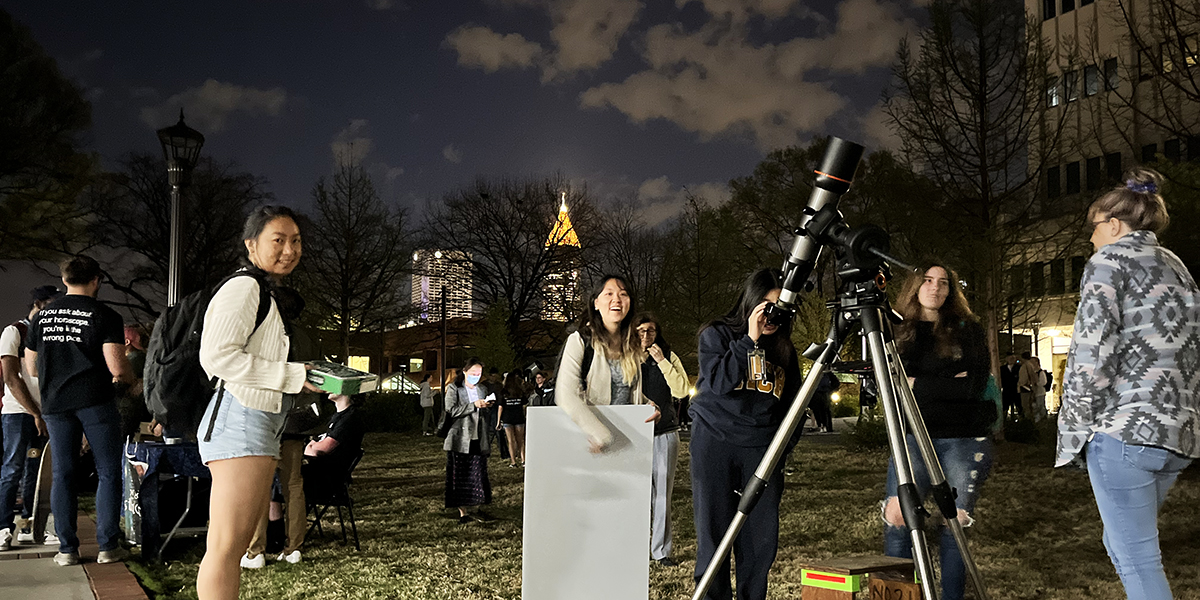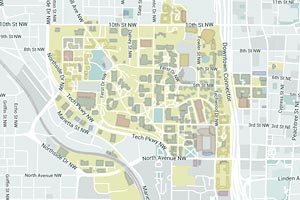
Undergraduate Research opportunities
Undergraduate students working in world renowned research groups in the school contribute to research published in leading scholarly journals and attend premier conferences in their fields. For undergrad research opportunities please look at the individual faculty profiles and webpages and contact faculty about any available positions.
Examples of research performed by undergraduates:
- Lila Nassar investigated the biophysics of cell cultures in the laboratory of Prof. Jennifer Curtis and has conducted research in quantum magnetism under the direction of Prof. Martin Mourigal.
- Vishal Sudahkar, working with Prof. Zeb Rocklin and his collaborators, conducted a theoretical study on the rigidity of tensegrities, objects with both rigid and flexible elements common in biology and engineering.
- As Letson Scholars, Sam Quinn conducted theoretical studies of turbulence in the group of Prof. Roman Grigoriev, while Yiting Pei attempted to optimize the spectroscopy of thullium atoms embedded in a noble gas matrix in the laboratory of Prof. Colin Parker.
- Elizabeth Mone, working with Prof. John Wise and graduate student Brandon Pries, studied the formation sites of massive black holes in the early universe.
- As a Petit Scholar, Julianne Tijani studied the entropy production of antibiotic-resistant bacteria in Prof. Peter Yunker’s laboratory.
- In Prof. Cadonati’s LIGO group Nadia Qutob used machine learning tools to train automatic glitch detection algorithms for use with gravitational wave data.
Registering for Undergraduate Research
After you have discussed prospective research with a research advisor, you will need request they sign the Undergraduate Research Agreement form so that you can register for the appropriate course (for credit or pay). You will be requesting that the form be sent to your email address for completion. After you have completed the form, it will then automatically forwarded to your research advisor's address for approval. Be sure you have reminded your research advisor that the form, coming from Dr. Eric Murray via Docusign, will arrive by email and require their signature. Your email address, and that of your research advisor, should be of the form gtacct@gatech.edu. Please use the DocuSign Address Book to search for and choose the appropriately formatted GT email addresses. This ensures your Agreement will be routed correctly.
- Request the form from docusign: PHYS Undergraduate Research Agreement and select "USE". If necessary, Log into GT DocuSign using your primary
GT email address (of the form gtacct@gatech.edu) and single sign-on. - Add the recipients (you and your research advisor) using the DocuSign Address Book, and select "SEND".
- In the email you receive, click on "REVIEW DOCUMENT".
- This will bring you to DocuSign, where you must agree to use electronic records and signatures, then click "CONTINUE".
- Fill out all required fields. Note that every field is required, except "level and basis" for "Other" type, which should only be filled out when "Other" is selected.
- Click "SIGN", and then after signing, "FINISH".
- You can check the status of your form on the Agreements page in DocuSign.
- The "three dots" menu for your form will allow you to make corrections if you discover an error in an email address.
- Once completed, a copy of the form is sent to the academic office and a permit will be issued for the appropriate course.
- Please contact the academic office if you have questions about or difficulties with completing the form.
Funding for Undergraduate Research
Undergraduate students can be funded for research through faculty grants, winning a President’s Undergraduate Research Award (PURA), or through a Letson Scholarship or Internship from the School of Physics. Both PURA and the School of Physics also award travel grants to support attendance at conferences.
Physics REU Program
The Georgia Tech Physics REU is a ten-week summer research program open for students outside Georgia Tech hosted by the School of Physics using funds from the National Science Foundation. Physics majors are invited to apply for the opportunity to work under the supervision of a physics faculty member on a focused research project. For more information visit the Physics REU website.


